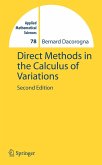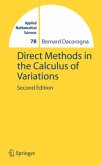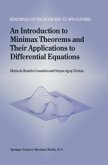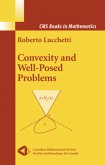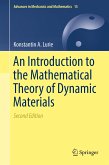The calculus of variations has a long history of interaction with other branches of mathematics such as geometry and differential equations, and with physics, particularly mechanics. More recently, the calculus of variations has found applications in other fields such as economics and electrical engineering. Much of the mathematics underlying control theory, for instance, can be regarded as part of the calculus of variations.
This book is an introduction to the calculus of variations for mathematicians and scientists. The reader interested primarily in mathematics will find results of interest in geometry and differential equations. I have paused at times to develop the proofs of some of these results, and discuss briefly various topics not normally found in an introductory book on this subject such as the existence and uniqueness of solutions to boundary-value problems, the inverse problem, and Morse theory. I have made "passive use" of functional analysis (in particular normed vector spaces) to place certain results in context and reassure the mathematician that a suitable framework is available for a more rigorous study. For the reader interested mainly in techniques and applications of the calculus of variations, I leavened the book with numerous examples mostly from physics. In addition, topics such as Hamilton's Principle, eigenvalue approximations, conservation laws, and nonholonomic constraints in mechanics are discussed. More importantly, the book is written on two levels. The technical details for many of the results can be skipped on the initial reading. The student can thus learn the main results in each chapter and return as needed to the proofs for a deeper understanding.
This book is an introduction to the calculus of variations for mathematicians and scientists. The reader interested primarily in mathematics will find results of interest in geometry and differential equations. I have paused at times to develop the proofs of some of these results, and discuss briefly various topics not normally found in an introductory book on this subject such as the existence and uniqueness of solutions to boundary-value problems, the inverse problem, and Morse theory. I have made "passive use" of functional analysis (in particular normed vector spaces) to place certain results in context and reassure the mathematician that a suitable framework is available for a more rigorous study. For the reader interested mainly in techniques and applications of the calculus of variations, I leavened the book with numerous examples mostly from physics. In addition, topics such as Hamilton's Principle, eigenvalue approximations, conservation laws, and nonholonomic constraints in mechanics are discussed. More importantly, the book is written on two levels. The technical details for many of the results can be skipped on the initial reading. The student can thus learn the main results in each chapter and return as needed to the proofs for a deeper understanding.
From the reviews:
"I find this book a very useful supplementary reading for undergraduate students and a good teaching aid for lecturers of topics involving traditional variational calculus (as e. g. mathematical physics). It is written with a deep pedagogical attention ... . According to my classroom experience with undergraduate physicists, the presentation of the examples in the book may be very helpful ... . It can also be appreciated that the author tries to present the results showing motivation and heuristical ideas for each crucial theorem."
(L. L. Stachó, Acta Scientiarum Mathematicarum, Vol. 71, 2005)
"The calculus of variations is one of the latest books in Springer's Universitext series. As such, it is intended to be a non-intimidating, introductory text ... . I enjoyed reading The calculus of variations. Brunt writes in a lucid, engaging style ... . can be used in a variety of undergraduate and beginning postgraduate courses. There is sufficient meat, both in the range of examples treated and in the development of the underlying mathematics ... that most of its intended audience will just be grateful ... ."
(Nick Lord, The Mathematical Gazette, Vol. 89 (516), 2005)
"The author describes this book as suitable for a one semester course for advance undergraduate students in math, physics or engineering. ... Accordingly, I chose to use this book as my primary reference for presenting the course ... . From my perspective, the book was pitched at a good level for the students I was teaching ... . Overall I enjoyed this book, and would unreservedly recommend it ... . The book really brought home to me the elegance of this subject ... ."
(Matthew Roughan, The Australian Mathematical Society Gazette, Vol. 32 (1), 2005)
"This text provides a friendly and ... elementary introduction to the calculus of variations. ... The emphasis is on well-chosen examples used to obtain the necessary heuristics for developing the theoretical background. ... Due to its concrete and well-organized approach, the book constitutes a valuable addition to the text book literature on the calculus of variations."
(M. Kunzinger, Monatshefte für Mathematik, Vol. 147 (1), 2006)
"Bruce van Brunt shows his love of the subject in his new book The Calculus of Variations ... . Brunt gives us a nice historical introduction to the calculus of variations. ... The exercises have ... been polished and sharpened in the classroom. ... this is a well crafted, reasonably priced book that would be a fine introduction to a fascinating subject that not enough mathematicians know about."
(Ed Sandifer, MathDL, May, 2004)
"Professor van Brunt's Calculus of Variations is an easily understandable introductory account of the (classical) Calculus of Variations ... . This text is aimed at the beginning graduate and advanced graduate students of mathematics and physics as well as engineering. ... The references contain 75 items ... ."
(R. Thiele, Zeitschrift für Analysis und ihre Anwendungen, Vol. 24 (4), 2005)
"I find this book a very useful supplementary reading for undergraduate students and a good teaching aid for lecturers of topics involving traditional variational calculus (as e. g. mathematical physics). It is written with a deep pedagogical attention ... . According to my classroom experience with undergraduate physicists, the presentation of the examples in the book may be very helpful ... . It can also be appreciated that the author tries to present the results showing motivation and heuristical ideas for each crucial theorem."
(L. L. Stachó, Acta Scientiarum Mathematicarum, Vol. 71, 2005)
"The calculus of variations is one of the latest books in Springer's Universitext series. As such, it is intended to be a non-intimidating, introductory text ... . I enjoyed reading The calculus of variations. Brunt writes in a lucid, engaging style ... . can be used in a variety of undergraduate and beginning postgraduate courses. There is sufficient meat, both in the range of examples treated and in the development of the underlying mathematics ... that most of its intended audience will just be grateful ... ."
(Nick Lord, The Mathematical Gazette, Vol. 89 (516), 2005)
"The author describes this book as suitable for a one semester course for advance undergraduate students in math, physics or engineering. ... Accordingly, I chose to use this book as my primary reference for presenting the course ... . From my perspective, the book was pitched at a good level for the students I was teaching ... . Overall I enjoyed this book, and would unreservedly recommend it ... . The book really brought home to me the elegance of this subject ... ."
(Matthew Roughan, The Australian Mathematical Society Gazette, Vol. 32 (1), 2005)
"This text provides a friendly and ... elementary introduction to the calculus of variations. ... The emphasis is on well-chosen examples used to obtain the necessary heuristics for developing the theoretical background. ... Due to its concrete and well-organized approach, the book constitutes a valuable addition to the text book literature on the calculus of variations."
(M. Kunzinger, Monatshefte für Mathematik, Vol. 147 (1), 2006)
"Bruce van Brunt shows his love of the subject in his new book The Calculus of Variations ... . Brunt gives us a nice historical introduction to the calculus of variations. ... The exercises have ... been polished and sharpened in the classroom. ... this is a well crafted, reasonably priced book that would be a fine introduction to a fascinating subject that not enough mathematicians know about."
(Ed Sandifer, MathDL, May, 2004)
"Professor van Brunt's Calculus of Variations is an easily understandable introductory account of the (classical) Calculus of Variations ... . This text is aimed at the beginning graduate and advanced graduate students of mathematics and physics as well as engineering. ... The references contain 75 items ... ."
(R. Thiele, Zeitschrift für Analysis und ihre Anwendungen, Vol. 24 (4), 2005)




